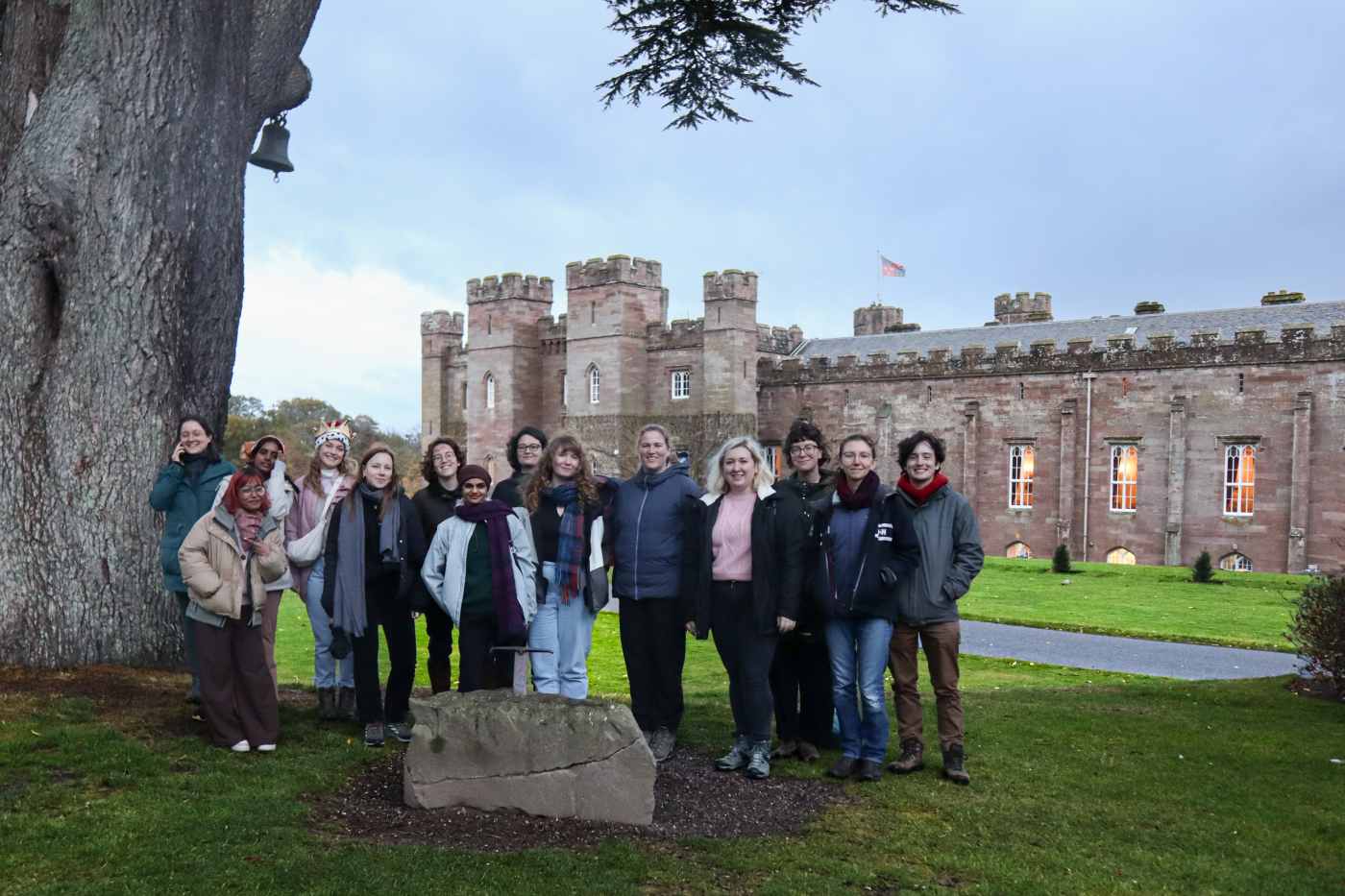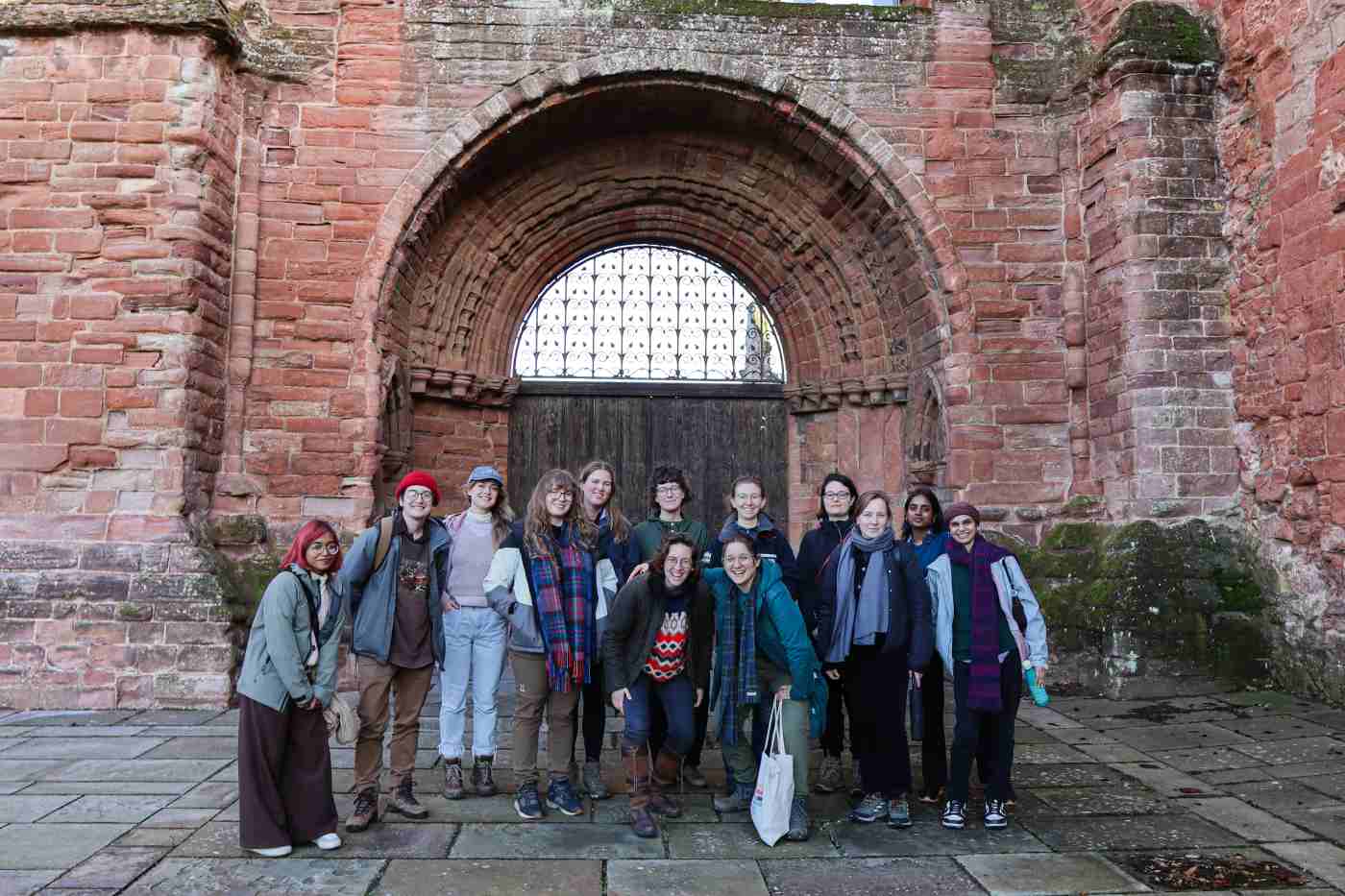Spook-tacular Stones: A Postgraduate Field Trip Reflection
Published: 24 November 2025
A postgraduate fieldtrip - report by Gala Georgette
On an eerie afternoon on the 31st of October, fourteen postgraduate students including four Masters students and ten PhD students traded Glasgow’s familiar seminar rooms for the mist-cloaked heartlands of Scotland. Over two days, we explored themes of Scottish kingship, independence, and Pictish legacies and, somehow, encountered four different Stones of Destiny in just 30 hours. A statistical improbability? Perhaps. A Halloween miracle? Absolutely.
But which one was the real Stone of Destiny? Read on … if you dare.
We set off by minibus at 1pm, costumes in tow. By late-afternoon, we arrived at Scone Palace, once the beating coronation heart of medieval Scotland. Moot Hill felt particularly atmospheric beneath the autumn light. Atop the hill overlooking the palace sat a solemn stone, located where the Stone of Destiny would have once been used for coronations: Stone Number One. After a fantastic tour from palace staff, the site revealed other unexpected delights: a regal white peacock named Alexander greeted us like the true monarch of the grounds, and the hedge maze became genuinely spooky as dusk fell.
After checking into our accommodation and freshening up, we gathered for a convivial dinner. Curiously, several colleagues had transformed into spooky figures: a sheep, a witch, a king, a devil, and a vampire. Whether this was Halloween magic or not, the jury remains out.
The next morning began with a crisp walk to Perth Museum, home to the newly displayed Stone of Destiny: Stone Number Two. Standing before this emblem of Scottish sovereignty, we reflected on its layered past, from medieval inaugurations to modern political symbolism. It looked like the real Stone. It felt like the real Stone (not that we were allowed to touch it – this is for dramatic effect only). It had signage insisting it was the real Stone. But, given the infamous student-led heist from Westminster Abbey in the early ’50s by University of Glasgow students (yes, really), could it truly be the original? The museum staff understandably gave us (a group of University of Glasgow students) an extra hint of side-eye.
From Perth, we travelled east to Arbroath, where lunch offered the chance to sample local heritage in the form of Arbroath Smokie, a type of smoked fish. We then visited Arbroath Abbey where, beneath the shadow of the Declaration of Arbroath, we encountered Stone Number Three. The setting was dramatic, the ambience was perfect … but it still wasn’t the last one we’d encounter.
By mid-afternoon, we began the journey back to Glasgow. Spirits were high (pun absolutely intended) as music and chatter filled the minibus.
After the official trip concluded, a small group of us found ourselves at the Arlington pub in Woodlands while resident minibus driver and overall legend Meike waited for her lift home. And there, to our amazement, we discovered Stone Number Four. The Arlington proudly declares that their stone is the real one. No plaque, no museum-grade lighting, just quiet, unwavering confidence. And honestly, after 30 hours of stones, replicas, historical symbolism, and mild sleep deprivation, we were in no position to argue.
So … which stone was the real Stone of Destiny? Moot Hill’s atmospheric contender overlooking the palace? The museum’s officially declared artefact? The abbey’s stately stone? Or the pub stone with unparalleled self-belief?
In true Halloween fashion, the mystery remains delightfully unsolved (and I’d quite like to return to the Arlington, so I’m not weighing in publicly).
Beyond the historical insights, what made this trip truly memorable was the sense of community it fostered. Sharing meals, stumbling through hedge mazes in the dark, and discussing research in relaxed settings created space for genuine connection between Masters and PhD students. These moments remind us that academic life thrives not only in libraries and seminar rooms but also in the laughter of a minibus, the quiet ruins of an abbey, and the surprising company of a benevolent peacock.
We returned with a renewed appreciation for Scotland’s layered past and for the colleagues who make exploring it such a joy.
A huge thank you to the archaeology unit for supporting this spook-tacular trip and making it happen!
First published: 24 November 2025
<< Latest news




